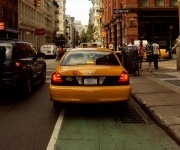 A typical scene in a New York bike lane, one of hundreds documented in photos by a single rider.Photo: bitchcakes
A typical scene in a New York bike lane, one of hundreds documented in photos by a single rider.Photo: bitchcakes
“Those scofflaw bicyclists!”
You hear that phrase a lot, or a version of it.
It’s true that, at least in New York City, there’s probably a scofflaw in any given bike lane at any given time.
But chances are high it’s not the person on the bicycle.
So observed the staff of Manhattan Borough President Scott Stringer when he sent them out to 11 bike lanes in Manhattan to record every single traffic infraction occurring in the lanes.
The unscientific results (download them here) evoke a vivid, chaotic, and very New York streetscape. While reading it, you can almost hear the honking in the background.
The report shows that 741 of the 1,700 total infractions recorded — more than a third — involved people walking or standing in a bike lane. On one block where this type of thing was particularly rampant, a collision was observed between a person on a bike and a person stepping into the bike lane.
Of the infractions, 353 involved the bike lane being blocked outright. Most of these impediments were motor vehicles, some parked and others moving, fast. Of these, 18 percent were taxis and limos and 13 percent were publicly owned vehicles. Particularly of note in the report were a school bus that idled in one bike lane for seven minutes and examples of “unmarked Police vehicles in apparent non-emergency situations cutting through protected bike lanes.”
Additionally, there were 77 instances of someone opening a car door into the bike lane, causing a bicyclist to swerve into car traffic.
Cyclists were observed riding in violation as well. Some 242 were seen going the wrong way in the lane (including one two-hour period at one block where there was more wrong-way than right-way traffic), and 237 were seen proceeding against a red light.
None of this is surprising, given Manhattan’s thriving pedestrian culture, high population, and density. People were spilling off of sidewalks and into car traffic long before bike lanes were a gleam in the city’s eye, and likewise people were looking for creative places to park and shortcuts around traffic since traffic congestion was invented. People on bicycles, meanwhile, have simply been trying to get where they’re going in one piece.
There’s a tendency to talk about people who ride bikes as though they’re a lawless bunch of yahoos. This study is a breath of fresh air in showing that no, they are simply, like all other people, responding to an environment that doesn’t always serve their needs. When you’re driving, the extra space a bike lane offers is a matter of mobility and convenience; if you’re riding a bike, it’s a matter of being seen and staying alive.
People run red lights on bikes not out of wanton disrespect for the world’s moral order, but because when you’re riding in a sea of cars occupied by people who probably don’t notice or care about your existence, you’re much safer getting as far ahead as possible.
So it’s a relief to hear that the study’s policy recommendation to address red-light compliance is not enforcement or even education but installing more bike boxes. A bike box — basically a space between the stop line for cars and the crosswalk where someone on a bike can wait for the light to change in a more visible position — provides a safer and more comfortable alternative to running the light, rather than penalizing or reforming behavior that’s already motivated by safety.
(In the meantime, the New York Police Department has announced a campaign to crack down on cyclists who run lights and ride on the sidewalk.)
Other recommendations in the study are worth reading. They include dedicating an enforcement patrol to keep the bike lanes free for bikes to use (currently this is done by clowns); better parking management so that delivery vehicles always have reserved spaces; more signage; an awareness campaign for taxi users; and more bike lanes that are physically separated from traffic.
New York City’s push for bicycle infrastructure in the last two years is bold, comparatively speaking. But New York, and other cities with similar ambitions to increase cycling mode share, need to think beyond bike lanes. Narrow strips of pavement wedged in as an afterthought onto streets that are still very much designed and operated for the convenience of motor vehicle traffic will never do anything but continue to marginalize (and, in the eyes of the public, criminalize) people who use them.
Imagine what might happen if people riding bikes and walking were extended the same engineering courtesies that have created an environment where anyone can drive a car through the city and expect to survive. The equation needs to be reversed. Only when people have enough space to walk and bike around the city in safety and comfort should consideration be given to the free flow of private automobiles driven in from wealthy suburbs.
The Manhattan Borough president’s call to “respect the lane, clear the path” is a compelling one that needs to be heard by every person idling, driving, walking, or riding the wrong way in the bike lane. But most of all, it needs to be heard by people at work deciding the future of the city’s streets.



